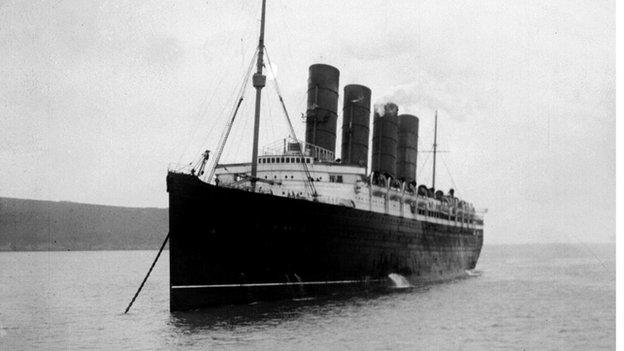Remembering the Lusitania: One passenger's remarkable story of survival
- Published

"She was presumed dead and was left among the pile of other dead bodies. Fortunately her brother John noticed her eyelid flutter and eventually they were able to resuscitate her."
That is how Colleen Watters has described the miraculous survival of grandmother Nettie Moore when the Lusitania was sunk 100 years ago.
Nettie lived through the tragedy but she suffered huge personal loss, finding it difficult to talk about the events of that day for the rest of her life.
On 7 May 1915, the Lusitania ocean liner, travelling from New York to Liverpool, was hit by a torpedo fired from a German U-boat. The ship sank off the southern coast of Ireland, killing approximately 1,200 people, including 94 children.
The sinking of the 'Lusi', one of the largest, fastest and most luxurious passenger liners of its day, caused widespread shock and outrage.
The anti-German sentiment it provoked was used as a recruitment tool in the British war effort.
On the 100th anniversary of the sinking of the Lusitania Colleen Watters tells the story of her grandmother's survival
But for Colleen Watters and the parishioners at Holy Trinity Church, Drumbo in County Down, the Lusitania is a very personal tragedy.
"My grandmother, Nettie Moore, grew up in Ballylesson, County Down, and her childhood sweetheart was Walter Mitchell, who was the son of the rector at the local Holy Trinity Church in Drumbo," said Colleen.
In 1912, Walter was asked to take up a position in a mill in Newark, New Jersey, so Walter and Nettie got married and emigrated.
The couple had a son, also named Walter, in the summer of 1914. But a combination of Walter Sr's mother dying suddenly and his company needing him home led the family to book their tickets for the Lusitania, along with Nettie's brother John.
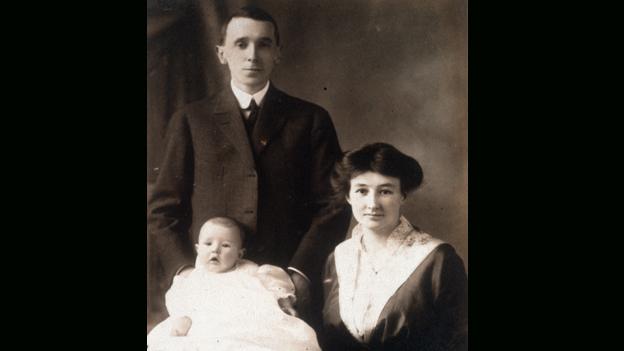
Nettie Moore with her husband Walter and son Walter Jr
Tragedy strikes
Friday 7 May 1915 had begun as a beautiful day, with the sea very calm.
"My grandmother always emphasised how happy they were on the boat," said Colleen. "They had just finished lunch when Walter and Nettie went down to the cabin to see the baby who was being looked after while John joined his friends playing cards."
The torpedo struck just as they were getting into the cabin. They somehow managed to get into a lifeboat, but the lifeboat sank slowly in the water because there were no bungs in it.
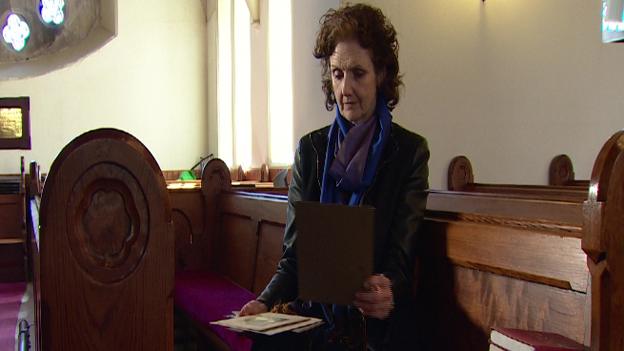
Colleen Watters reflects on her grandmother's incredible survival
"Walter was holding his son but the baby died quite soon of exposure. They were trying to hold onto an upturned lifeboat. Walter eventually said 'I can't hold on any longer' and slipped away."
"Their bodies were taken out of the water. My grandmother said she remembered being dragged by her feet, and her head bouncing on the deck of the ship. She was taken for dead and she was left with the dead bodies on the quayside."
Miracle on the quayside
Fortunately, John had been picked up by a tugboat and brought to Cobh, County Cork (then called Queenstown).
He saw the bodies being dragged from the water and found Nettie and Walter's bodies, initially assuming they were both dead. John thought he saw Nettie's eyelid flutter and they were able to resuscitate her.
Reliving the final moments of the Lusitania
Colleen described the heartache her grandmother had to endure:
"I have been told that Nettie was in a shoe shop in Cork, and John was buying her shoes so they could come home. There she met some sailors who said they had found the body of a beautiful baby and she begged them to tell her where was the baby, what did they do with it, as she was sure it was Walter. But despite the best efforts they weren't able to locate the body."
Colleen and her family had always believed that the baby's body had never been discovered, but she recently found out this isn't the case.
"The baby's body is actually buried in a mass grave in Cobh. There is a letter where Nettie is trying to get the council to get the body back but they won't do it and there's nothing can be done. So the baby is buried in Cobh and she didn't ever tell anyone that."
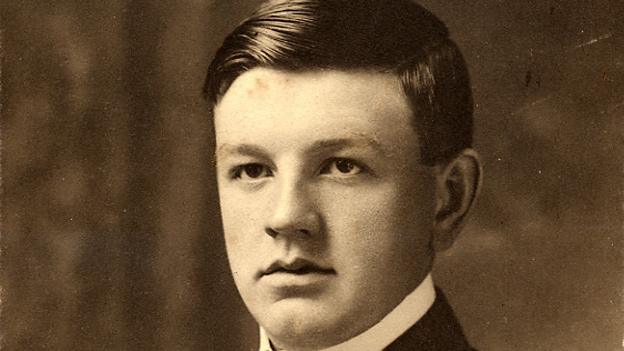
Nettie's brother John helped save her life
John and Nettie arrived home at midnight on the Sunday having travelled all the way from Cobh with the coffin, where newspaper reporters were waiting.
After the tragedy Nettie didn't sleep and was fearful she was going to lose her mind, as she struggled to come to terms with her loss.
Colleen said the doctor gave her grandmother simple advice:
"He told her you just have to do something that's very hard work. She decided she would take up nursing.
"She went to the Rotunda hospital in Dublin and trained as a midwife. It seems to have worked and having lost her own infant son, her new mission in life became to deliver other babies safely into the world."

More on the sinking of the Lusitania


The Lusitania wasn't the only historic event Nettie Moore was caught up in.
"She was working in the centre of Dublin in 1916, so she became embroiled in the Easter Rising.
"Some of the wounded were brought to the hospital. Allegedly, the British Army then came in looking for rebels.
"Nettie later said it was night-time when they came in and there was a lot of commotion, so she took the poker from the fireplace and went to see what the noise was.
"So wielding the poker she said 'no of course there aren't any rebels in my wards, don't you dare disturb any of my ladies'."
Devastated town
The survivors of the Lusitania sinking and the bodies of those who died were brought to the small town of Cobh.
Deborah Baume, who works at Cobh museum, has been reflecting on the huge effect the tragedy had on Cobh:
"Local people worked really hard in adversity to make sure survivors were well looked after.
"The bodies of those who had not survived had to be properly recorded. Coffins had to be sourced, graves dug, families notified and arrangements made for bodies to be repatriated.
"It was a task for which the town had no experience and yet they carried out the task efficiently and with humanity."
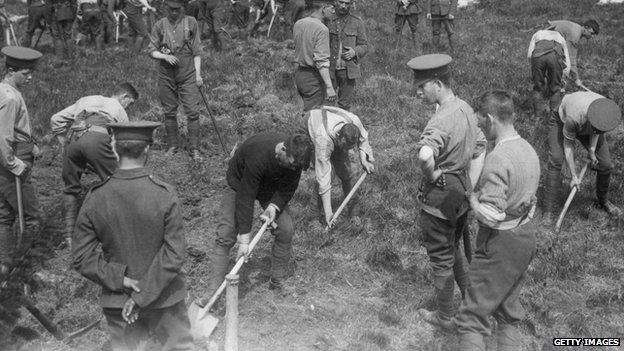
Soldiers dig a mass grave for the dead in a churchyard near Cobh
Outrage
The disaster provoked widespread outrage, particularly in Britain and the US, and rioters attacked German shops in England.
But amid the anger there were unanswered questions.
There was controversy as to why the Lusitania travelled without a Navy escort into what the Germans had designated a war zone, with a declaration in newspapers that any ships travelling from the US to the UK would be in danger. Many people felt the Germans would not be audacious enough to attack a famous liner carrying many American citizens (the US was not involved in the war at the time).
Questions were also asked as to why the huge ship only took 18 minutes to sink, with speculation that the Lusitania had been carrying heavy ammunition, causing a fatal second explosion. At the time, the Germans claimed the ship was "carrying large quantities of war material".
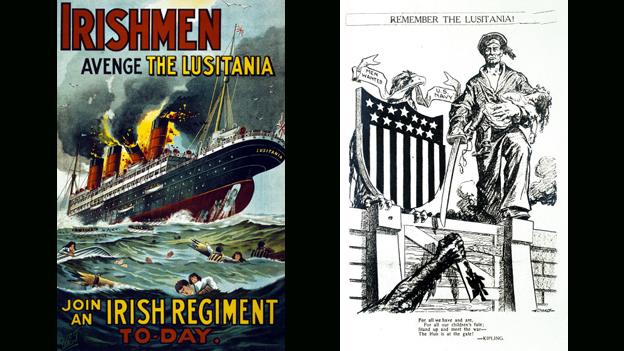
The Lusitania was used to encourage volunteers to sign up to fight in the war
In 1918, a New York court established that the Lusitania was carrying 4,200 cases of small arms ammunition but was neither armed nor carrying explosives, and experts agree that the sinking broke international law. Divers have surveyed the wreck, with no explosives ever found.
The tragedy carried huge significance, as Winston Churchill later described:
"In spite of all its horror, we must regard the sinking of the Lusitania as an event most important and favourable to the Allies. The poor babies who perished in the ocean attack struck a blow at German power more deadly than could have been achieved by the sacrifice of 100,000 men."
It is believed that 82 Irish people died in the sinking of the Lusitania.
Holy Trinity Church, Drumbo, where both Nettie and Walter are buried, is commemorating all who died in a service on Sunday 10 May.
To this day Colleen Watters is still learning new details about the tragedy, and she said its impact never left Nettie Moore.
"My grandmother very rarely spoke about the Lusitania, as it was just too painful. It was deeply shocking to many people at the time, particularly with the number of children killed."
- Published27 March 2015
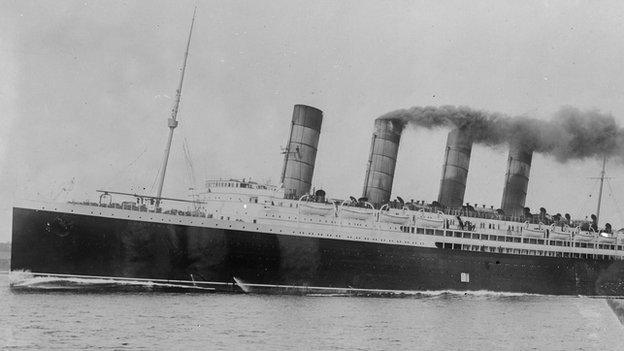
- Published1 May 2014
